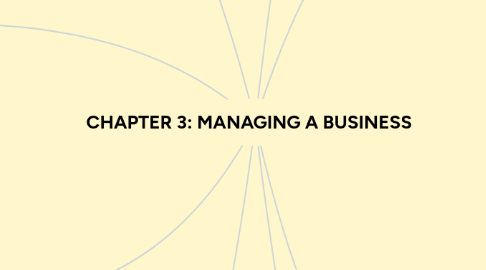
1. 3.1What is management
1.1. Management: The process of administering and coordinating resources effectively, efficiently, and in an effort to achieve the goals of the organization.
1.2. Manager: Member who is responsible for planning, organizing, leading, and controlling the activities.
2. 3.2 The management process / functions
2.1. 3.2.1 Management plans
2.1.1. 1) Standing plans
2.1.1.1. -Policy
2.1.1.2. -Procedure
2.1.1.3. -Rules
2.1.2. 2) Single use plans
2.1.2.1. -Program
2.1.2.2. -Projects
2.1.2.3. -Budget
3. 3.2.3 What is leading?
3.1. -Motivating and directing the members of the organization .
3.1.1. 1)Leader: People who can influence the behaviour of others without having rely on force of those accepted by others.
3.1.2. 2) Leadership: The process of directing the behaviour of others toward the accomplishment of some objective.
3.1.2.1. i) Leadership involves in:- - Creating a vision of the future. -Devising strategy for achieve that vision. - Communicating the vision so that everyone understands and believes in it.
3.1.2.2. ii) Importance of leadership:- - Make contributions to organization. - Enhance and obtain cooperation. - Encourage teamwork. - Motivate employees.
4. 3.2.2 What is organizing?
4.1. 1) Organizing: Means to structure /arrange the relationship between people.
4.2. 2) Organization: A group of individuals who work together toward common goals.
5. 3.2.4.1 Controlling process
5.1. FIRST STEP: SETTING STANDARDS FOR PERFORMANCE.
5.1.1. Whenever possible, the standards should be set in a manner that allows them to be compared with actual performance.
5.2. SECOND STEP: MEASURING ACTUAL PERFORMANCE.
5.2.1. An organization must decide:- -What to measure. -When to measure. -How frequently to measure.
5.3. THIRD STEP: COMPARING ACTUAL PERFORMANCE WITH STANDARDS.
5.3.1. This step involves determining if actual performance compared to standards falls within acceptable limits.
5.4. FOURTH STEP: RESPONDING TO DEVIATIONS.
5.4.1. ~If the deviation from performance is unacceptable, then corrective action is warranted. ~If the deviation is acceptable, no correction action will be taken.
6. 3.2.3.1 Types or sources of power
6.1. Personal
6.1.1. Referent: Ability to influence others based on personal liking, charisma & reputation. For example: Dr. Mahathir - MSC.
6.1.2. Expert: Power to influence another person because of expert knowledge and competence. For Example: Doctor, Engineer, Lawyer.
6.2. Position
6.2.1. Legitimate: Power that stems from formal authority. For example: JPJ, PDRM.
6.2.2. Reward: Derived from control over tangible benefits example promotion, work schedule. For example: Rector, UITM Campus.
6.2.3. Information: Contol over information. For example:Kementerian Kesihatan Malaysia (KKM) controls the latest news on Covid-19 updates.
6.2.4. Coercive: Power to discipline, punish and withhold rewards. For example: Lectures-students.
7. 3.2.4 What is controlling
7.1. Controlling: Monitoring how well the organization is achieving goals and take action to maintain, improve, and correct performance.
7.1.1. 1) Control: making something happen the way it was planned to happen.
7.1.2. 2) Controlling: the process managers go through to control.
7.1.3. 3) Organizational control: The systematic process through which managers regulate organizational activities to make them consistent .
8. 3.2.4.2 Types of controlling
8.1. Preventive/ feed forward/ steering control
8.1.1. Focuses on detecting undesirable material, financial, or human resources that serve as inputs to the transformation process.
8.2. Concurrent/ screening control
8.2.1. Focuses on the transformation process to ensure that it is functioning properly.
8.3. Feedback/ post action/ corrective control
8.3.1. Focuses on discovering undesirable output and implementing corrective action.
9. 3.3 Levels of management
9.1. 3.3.1 Managerical levels
9.1.1. 1)TOP LEVEL ~Establish objectives, policy & strategy, make long-term decisions. E.g.: CEO, President.
9.1.2. 2) Middle level management ~Interpret top management directives into operating plans. E.g: Marketing Manager, Human Resources Manager.
9.1.3. 3) Frontline managers ~Direct & support work on non-managerial personnel, make short-term operating decision. E.g.: Supervisor.
